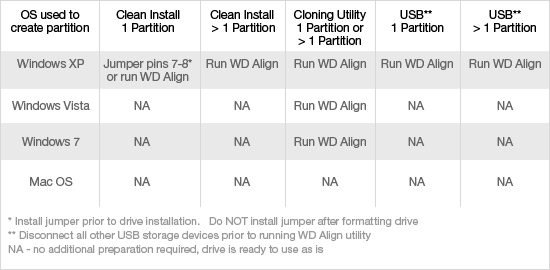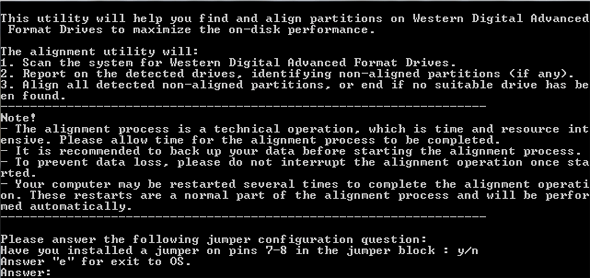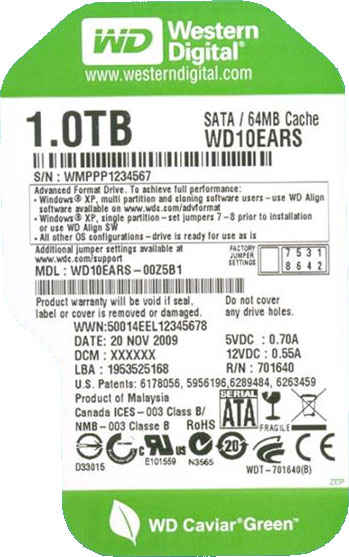Western Digital’s Advanced Format: The 4K Sector Transition Begins
by Ryan Smith on December 18, 2009 12:00 AM EST- Posted in
- Storage
What Operating Systems Are Affected
Now that we’ve dealt with what 4K sectors are, why Western Digital and other drive manufacturers are switching to them, and what the potential pitfalls of 512B emulation are, we can look at the specific cases where there are potential problems.
The big problem is that while the first work on 4KB sectors started in 1998, it wasn’t until after the launch of Windows XP that the matter came to a head. As a result the 5.x versions of Windows (2K, XP, 2K3, WHS) have no concept of 4KB sectors. Even though all operating systems will be seeing 512B sectors through the use of emulation technology on the drive controller, out of Windows only Win 6.x (Vista, 2008, Win7) and later have been programmed to take in to account the alignment issues we mentioned earlier. Win 5.xx in particular has a nasty habit of starting the first partition at LBA 63, which is 1 512B sector misaligned from a 4K sector boundary. In essence, the issue is that Win 5.x will always create a misaligned first partition and will have poor default performance as a result.
Although Win 5.x is the primary victim here, other versions of Windows can also be affected in edge cases. Along with the need for 4K-aware operating systems, drive imaging software needs to be 4K-aware. Otherwise such imaging software may inadvertently create misaligned partitions too. As such, Win 6.x is also affected by alignment issues when imaging software is used, as some (and perhaps all?) imaging products currently available will write misaligned partitions and/or clusters.

Notably, Linux and Mac OS X are not affected by this issue. Western Digital has tested both of these operating systems, and officially classifies them as not-affected. Ultimately we suspect that if you went back far enough you could find older versions of these OSes that are affected, but unlike Win 5.xx, there’s not a significant legacy user base to worry about. Along these lines, Linux and Mac OS X drive imaging products are similarly unaffected. In their testing, imaging tools such as SuperDuper didn’t run in to any alignment issues, so Linux and Mac OS X users are not affected in any way by 4K sectors. It’s only Windows and Windows imaging products that are affected.
In order to solve the misalignment issue, Western Digital is offering two solutions. The first solution for correcting misaligned partitions is specifically geared towards Win 5.x, and that is an option on the drive itself to use an offset. Through the jumpering of pins 7 and 8 on an Advanced Format drive, the drive controller will use a +1 offset, resolving Win 5.xx’s insistence on starting the first partition at LBA 63 by actually starting it at LBA 64, an aligned position. This is exactly the kind of crude hack it sounds like since it means the operating system is no longer writing to the sector it thinks its writing to, but it’s simple to activate and effective in solving the issue so long as only a single partition is being used. If multiple partitions are being used, then this offset cannot be used as it can negatively impact the later partitions. The offset can also not be removed without repartitioning the drive, as the removal of the offset would break the partition table.
The second method of resolving misaligned partitions is through the use of Western Digital’s WD Align utility, which moves a partition and its data from a misaligned position to an aligned position. This is the recommended solution for using multiple partitions under Win 5.xx, along with correcting any misaligned partitions generated by imaging software. For that matter we’d consider it the recommended solution for single-partition drives being used under Win 5.x too, as there’s no need to worry about offsets and breaking the partition table.

The utility is available for download from Western Digital’s site, and while it isn’t pretty (it’s a scripted CLI application) it gets the job done. The amount of time needed to run the utility is based on the amount of data that needs to be moved rather than the partition size (it simply ignores empty space), so it’s best to run the utility immediately after creating a partition or installing Windows, as there’s less data to move around.
Unfortunately, at this point the utility also serves as the only way to identify an Advance Format drive without physically looking at it. Looking at the ATA spec, it looks like there’s a provision for asking a drive its native sector size (regardless of 512B emulation) but at this point there’s no such tool beyond the WD Align utility itself. This in and of itself isn’t a big issue, but if you’re a techie that ever finds themselves working on an XP machine with a 1TB+ Western Digital drive, you’ll want to keep an eye open.
The First Drives & The Future
So what are the first Advanced Format drives and when are they due? The first drives will be Caviar Green drives using multiple 500GB platters – so the 1TB, 1.5TB, and 2TB Caviar Green. These drives will be shipping any day now, and can be identified through two different methods: 1) They all have 64MB of cache - the first WD Caviar Green drives to come with that much cache - and 2) They all have EARS in the drive model number, e.g. WD10EARS.

As we stated before, in spite of the benefits of 4K sectors, Western Digital is not pushing these drives as part of any major product launch. Rather they’re going to be quietly trickling in to the marketplace. Expect a price premium at first (as with any other new product) before settling down. We don’t have a drive on-hand to review, but from the fact that this is a low-key launch, WD isn’t painting any expectations of a performance difference, although this will be something to test in the future.
And on that note, expect to see similar launches from everyone else within the next year. The last IDEMA plan called for everyone to have 4K-sector drives by 2011, so everyone should be launching within the next year here. Everyone using 512B emulation is going to run in to the same teething issues with Win 5.x – so while other vendors may handle things slightly differently, ultimately everyone is going to be compensating for Win 5.x in some manner (in case it hasn’t been made clear here, these guys would be ecstatic for Win 5.x to go away quickly).
Farther down the road will be the exposure of 4K-sectors to the operating system itself. Linux and Win 6.x are set (and we believe that Mac OS X is too), the only limit right now is the desire to do a phased transition to make thing easier for legacy users. Since 4K-sector drives won’t work on Win 5.x at all, drive manufacturers can’t put them on the market so long as there’s a significant legacy base. 2014 – the year that extended support ends for WinXP – looks like a good year to finally complete the move to 4K sectors.










86 Comments
View All Comments
strikeback03 - Friday, December 18, 2009 - link
I'd imagine these "power users" would be the ones using an OS that knows what to do with 4k sectors, and would not have the performance problems XP would. And it would be nice if they had a jumper setting (enabled as shipped) to enable or disable the 512b emulation. Thus the only ones likely to disable the 512b emulation are the ones who know what they are doing.wolrah - Friday, December 18, 2009 - link
This is my thought as well. When SATA2 was new and some first-gen SATA controllers were found to have problems with drives running in SATA2 mode, Seagate shipped their Barracuda 7200.8 (I think) with a jumper installed that disabled SATA2 by default. At the time there was little performance benefit unless you had support for NCQ the whole way up the stack and were multitasking heavily, so most users probably still to this day have that jumper installed whether they need it or not and are none the wiser. Those who knew what they're doing however could remove the jumper and gain a slightly faster burst transfer rate out of disk cache and the various protocol enhancements such as NCQ.leexgx - Saturday, December 19, 2009 - link
due to hdds not braking past 90MB/s the jumper on made there drives the most compatible drives around as i have had problems in the past with puling that jumper off on some motherboards (or none segate hdds) not working stable with Sata 2same issue with Nvidia and Sata 2 on there apple systems wish SSDs had an option to set Sata 1 mode as the only SSD that you most likely going to always work is the corsair S128 as its Sata 1 only
Mr Perfect - Friday, December 18, 2009 - link
Yes, that would be a great option. I can't be the only one who'd love to enable real 4KB sectors on all of my Windows 7 machines going forward.ltcommanderdata - Friday, December 18, 2009 - link
So Mac OS X doesn't seemed to have problems with Advanced Format, but what about Boot Camp? Will XP Boot Camp still have issues while Vista and Windows 7 Boot Camp won't or does the Boot Camp partition utility automatically properly aligns things for even Windows XP.Lukas - Sunday, December 20, 2009 - link
The bootcamp partitions aren't created by Windows XP, they're created by Mac OS X. Without having studied it, i'd bet that they will be aligned.Ryan Smith - Friday, December 18, 2009 - link
Good question; I don't have an answer to that.Mr Perfect - Friday, December 18, 2009 - link
I don't know if WD is answering followup questions, but could you ask if other virtual machines have this problem too? Specifically, I'm thinking of Windows 7's XP mode.leexgx - Saturday, December 19, 2009 - link
xp mode is an add-on to windows 7, as windows 7 will all ready be installed the XP mode install does not work at the disk level when it is installed (does not create partitions)for vmware if its File based VMs it same as win7 XP mode its not working at disk level when partitions are been made inside the VMs(think VMware can be disk based thought but most use file based)
pcfxer - Friday, December 18, 2009 - link
As of December 18, 2009, Bootcamp does NOT align the sectors any differently than the Microsoft installer would.